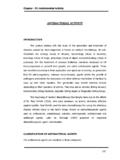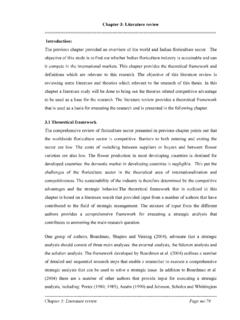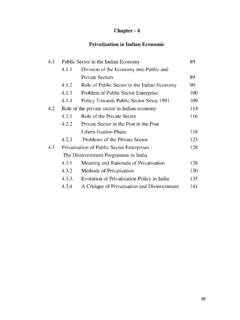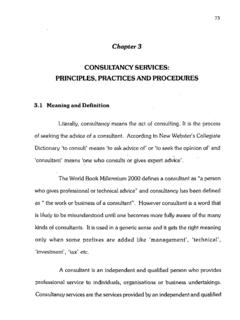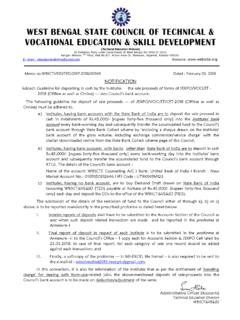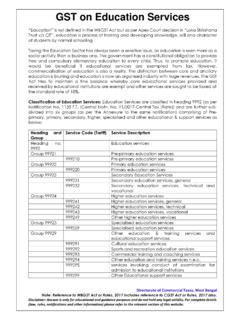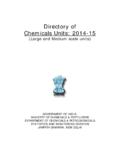Transcription of AUTONOMOUS ENGINEERING COLLEGES IN KARNATAKA: A PROFILE
1 CHAPTER- IV. AUTONOMOUS ENGINEERING COLLEGES IN karnataka : A PROFILE . Introduction Education has always been looked upon by the Indian culture as a holistic effort since time immemorial. Indian culture has held education as a core attribute of life, beginning from Gurukul type of education, where the disciples lived in the house of the Master who taught them, all things he knew, orally for several years. As a tradition, education is being looked upon holistically even today in India. The students learn with dedication, whatever be the discipline. Be it Medicine, ENGINEERING , Electronics, Humanities or any subject one is likely to get proper higher education in any of these fields in our country. Today the higher education programme is controlled and maintained by the University Grants Commission (UGC) of India.
2 It strives to keep the quality of education on par with the international standards. Education in India is a part of a heritage, India acquired during the British Rule. Since then all fields of education have remained up-to-date in quality and in quantity. Medical education, technical education or any type of professional education be it, have been updating themselves according to the growth of disciplines all over the world. Higher Education Compared to the past higher education is rampant, easily accessible and affordable in present times. COLLEGES and universities that offer different education schemes are aplenty. All of them offer an international quality of education. Today there are 42 central universities in India, which are funded by the Government of India.
3 Besides this, there are 130 universities, which have been accorded university status and are called "Deemed Universities". Graduating to the status of University means the concerned Institution is maintaining a global standard of education and they will have the most modern laboratories to import effective learning into the student's mind. The state governments, under UGC law, are entitled to establish their own universities, funded by the respective state government. 115. technical Education: The Nascent Stage technical education, unlike other types of professional education, has not had a long history. Though in the ancient and medieval periods, Man had built large brick and stone houses, castles, cities, huge temples, constructed long highways, dug good aqueducts and canals which show considerable knowledge of Civil and Hydraulic ENGINEERING .
4 One can also get a basic idea of the properties of building materials, this knowledge must have been derived empirically. Traces of Mechanical ENGINEERING are to be found in the manufacture and use of tools, means of transportation, simple machinery like lathes and drives and also in weapons of offence and defense. Rudiments of chemical ENGINEERING are to be seen in the old metallurgical practices. But there were no organised schools for teaching apprentices, the use of machinery or knowledge of processes; because knowledge passed from generation to generation of craftsmen and artificers, by word of mouth, and was thus confined to castes and guilds through inheritance. The industrial revolution with the advent of the Industrial Age, which was ushered in by the discovery of the steam engine by James Watt in 1780, and the ability to generate and handle large amounts of power was rendered possible, by the invention of the steam engine.
5 Men passed from dependence on human labour and hand tools to large and complicated machinery; production of commodities passed from cottage workshops to factories. Transportation by bullock-carts, horse-driven carriages, and wind or men driven boats, gave way to railroads and steamships. All this necessitated the construction of large machines, engines, ships and carriages, and gave rise to problems of industrial finance and labour. ENGINEERING and Technological Education in India up to 1947. The impulse for the creation of the Centres of technical training came from the British rulers of India and it arose out of the necessity for the training of overseers and supervisors for the construction and maintenance of public buildings, roads, canals and ports, along with the need for the training of artisans and craftsmen for the use of instruments, and apparatus needed for the army, the navy, and the survey department.
6 116. The first ENGINEERING college was established in the in 1847 for the training of Civil Engineers at Roorkee, which made use of the large workshops and public buildings there that were erected for the Upper Ganges Canal. The Roorkee college (or to give it its official name, the Thomson ENGINEERING college ) was never affiliated to any university, but has been giving diplomas which are considered to be equivalent to university degrees. In pursuance of the Government policy, three ENGINEERING COLLEGES were opened by about 1856 in the three Presidencies. In Bengal, a college called the Calcutta college of Civil ENGINEERING was opened at the Writers'. Buildings in November 1856; the name was changed to Bengal ENGINEERING college in 1857, and it, was affiliated to the Calcutta University.
7 It gave a licentiate course in Civil ENGINEERING . In 1865 it was amalgamated with the Presidency college . Later, in 1880, it was detached from the Presidency college and shifted to its present quarters at Sibpur, occupying the premises and buildings belonging to the Bishop's college . Proposals for having an ENGINEERING college at Bombay city having failed for some reasons, the overseer's school at Poona which eventually became the Poona college of ENGINEERING was affiliated to the Bombay University in 1858. For a long time, this was the only college of ENGINEERING in the Western Presidency. In the Madras Presidency, the industrial school attached to the Gun Carriage Factory became ultimately the Guindy college of ENGINEERING and was affiliated to the Madras University 1858.
8 In Bengal, the leaders of the Swadeshi Movement organized in 1907, a National Council of Education which tried to organize a truly National University, out of the many institutions it started, only the college of ENGINEERING and Technology at Jadavpur had survived. It started granting diplomas in mechanical and ENGINEERING courses in 1908, and in chemical ENGINEERING by 1921. The Calcutta University Commission, debated the pros and cons of the introduction of degree courses in mechanical and electrical ENGINEERING , one of the reasons cited, from the recommendations of the Indian Industrial Commission (1915, under the Chairmanship of Sir Thomas (Holland) against the introduction of electrical ENGINEERING courses is given in the following quotation from their report.)
9 117. The credit of first starting degree classes in mechanical and electrical ENGINEERING and in metallurgy belonged to the University of Banaras, thanks to the foresight of its great founder, Pt. Madan Mohan Malaviya during 1917. About fifteen years later, in the years 1931-32, the Bengal ENGINEERING college at Sibpur started mechanical ENGINEERING courses, electrical ENGINEERING courses in 1935-36, and courses in metallurgy in 1939-40. Courses in these subjects were also introduced at Guindy and Poona about the same time. Quite a number of ENGINEERING COLLEGES have been started since August 15, 1947. It is due to the realization that India has the vision of becoming a great industrial country, and would require a far larger number of engineers could be supplied by the older institutions.
10 In some cases, existing lower type institutions have been raised to the status of degree-giving COLLEGES . Post Independence Scenario The Industrial Revolution' of the 18th century laid the foundation of a technological civilization and gave rise to a new system of learning process which is known as technical Education . The technical education system brought out the concept of establishment of training institutions in order to meet the challenges of fast changing technological environment around the world. The foundation of technical education was laid in India almost at the same time as in Europe but its growth was stunted in the sub-continent till India became independent. In 1794, the English traders established a survey school at Madras to train Indian personnel in modern land survey and to assist British surveyors.
